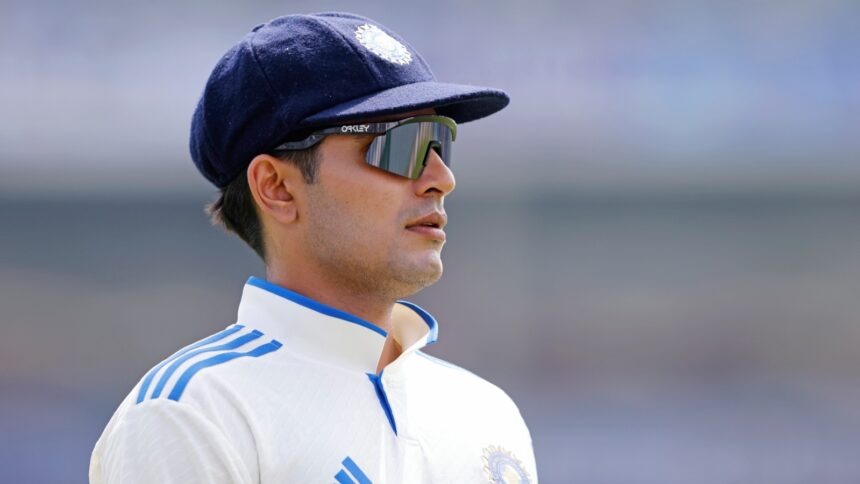It’s not often that a player who was nearly dropped just a year back becomes the Test captain. It’s definitely not often that a player who was dropped from the playing XI midway during the last Test series that India played, just months back, becomes the captain. But here we are, due to the big-ticket retirements of Rohit Sharma and Virat Kohli along with the selectors’ lack of confidence in the other captaincy candidates – Jasprit Bumrah, KL Rahul and Rishabh Pant – that Shubman Gill, 24, has been anointed as India’s Test captain.
In 2024 during the England home series, Gill, struggling with his form, almost lost his place in the Test side. But he bounced back strongly. Later he was on drinks duty for the Melbourne Test of the Border-Gavaskar Trophy this year in Australia. He got his place back only after captain Rohit decided to drop himself on a grassy-green Sydney track for the final Test of the series.
It’s what he did in that Test that needs a rewind, but first the lead-up to his anointment.
FOLLOW LIVE:
The has worked out favourably to his cause, and to the detriment of the other captaincy contenders. skipper Pant and his team were listless. At , Rahul wasn’t leading the side even when skipper got injured. Not to forget that Rahul was dropped after just one Test in India’s last home series last year, a historic whitewash defeat to New Zealand.
All-rounder , now the senior-most in the team, was never going to be seriously considered as a captain at this stage of his international career. Certainly not after MS Dhoni reinstalled himself to replace Jadeja as the captain midway during one IPL season.
Gill’s traits during IPL that has attracted the legends have been interesting. For Sunil Gavaskar, it was the “competitiveness”. Gill would be the first to rush to umpires when he was not happy with a decision. For Ravi Shastri, it was the way Gill remained “calm, composed”. Those adjectives are positive, though it’s perhaps better to lean in on the men who have been with Gill, in the same camp to understand how he functions. The former India players in the dressing room – coach Ashish Nehra, mentor and pacer – have all spoken about their captain to the IPL broadcaster.
Ishant’s views as a player from a few weeks back are probably the most telling; he cued up scenes from timeouts during IPL to make his interesting point.
“Timeouts are crucial. Sometimes Gill feels we should be bowling a particular type of delivery or this or that should happen. Then Ashish Nehra comes in and says, ‘no, the first thing that should happen is what the bowler wants’. And a good captain is a person who is a bowler’s captain. He should give the freedom to the bowler and back the bowler’s decisions. If that doesn’t work, then we go to plan B. That’s what Gill does. He is now learning a lot as a captain and I am sure in the upcoming years we will see ‘him happening way more’ than what he is doing right now,” Ishant said.
Learning to toggle that primary instinct with that of the team is good, and though there might not be “upcoming years” but mere days to see “him happening way more” for the sake of India. Though Ishant’s stressing for patience and more time is certainly something that all the stakeholders should keep in mind as Gill’s time as captain begins.
There was a line from Parthiv Patel too that shines a light on another facet of his functioning style. “He is very good with youngsters … makes his presence felt in the dressing room. He doesn’t talk much but his words carry a lot of weight,” Patel had said.
Not talking much or being shy is a trait also noted by the motor-mouth coach Nehra, who has had the greatest hand in moulding two of the current big stars in Indian cricket – Gill and .
“Someone like Gill if he can captain a team for 3-4 years, keeping his feet in the ground, and learning from past (mistakes) and progress – which is his nature, and he also remains a bit shy, then the sky is the limit,” Nehra had said a month back. “We have had conversations for a year. A person learns from his experience also. This year things will only go better and better. I am not talking about results but Gill as a person, as a captain, taking the (IPL) team forward.”
It’s clear that those who have worked with him do seem to believe that he is a work in progress, not a finished product or even potentially-ready as Graeme Smith was when he was asked to lead South Africa as a 22-year-old. But in extraordinary circumstances, certain bold decisions need to be taken- and with the exit of Rohit and Kohli, India had to swing this way.
There will be a temptation to see Gill’s rise as in line with ’s – the ‘prince’ in waiting taking over, but that would be missing a certain key nuance. Not only was Kohli not fighting for his own spot till the last instant as Gill has been now, his personality and demeanour had set him very early as a leader. Thus there was no major handwringing when MS Dhoni quit captaincy midway during a Test series as he and others thought Kohli was ready.
The flipbook of recent Indian Test captains show they were all ready: , Kohli, Dhoni, Anil Kumble, , . Tendulkar was thought to be born to lead India; so while the results didn’t go that way, there was no doubt when he took over at first. One has to hark all the way back to Mohammad Azharuddin when the board president Rajsingh Dungarpur suddenly asked him, “Mian, captain banoge?”to the surprise of the player himself to find a case of a captain with inherent doubts.
Gill is certainly more ready than Azharuddin was, but not as ready as the others that followed. Gary Kirsten, Gujarat Titans coach when Gill became captain last season, talked about how “he’s really keen to do the job” and how coaches “have to assist him”. Under Nehra’s care, Gill must have learnt a lot of nitty-gritties on the cricketing intelligence needed and he recently spoke about his biggest learning.
“There were a few games last year where I was thinking a lot and couldn’t do well. You play at your best when you don’t confuse captaincy with batting. Then Ashu pa (Nehra) told me just think as a batsman, don’t think as a captain, there is no great relation. That helped me a lot,” Gill said.
It’s vital learning, but he will also do well to temper the two, or rather work his way out as a batsman while playing in Tests. There were a couple of moments from the series-decider at Sydney in January this year that’s worth a rewind.
With the series hanging in line, after coming back into the team at expense of Rohit, on the last ball before lunch on opening day, he had an impetuous dash down the track to Nathan Lyon – and was stumped by miles. at first slip, and a couple of close-in fielders were sledging him about the time wastage, and his response was that charge to nowhere off the final ball. Then in the second innings, with the game in balance, he yet again rushed down the track, this time to the medium pacer Beau Webster, inside-edging to the wicketkeeper.
What would Gill the captain do in those moments now? His learning is he can’t let the captain dictate the batsmen, but he also has to find a way to curb the recklessness of a young batsman, and think more maturely as a captain. Fascinating times present fascinating challenges – and how he deals these little big moments, helped along by the coach , will determine his longevity as India’s new leader.








